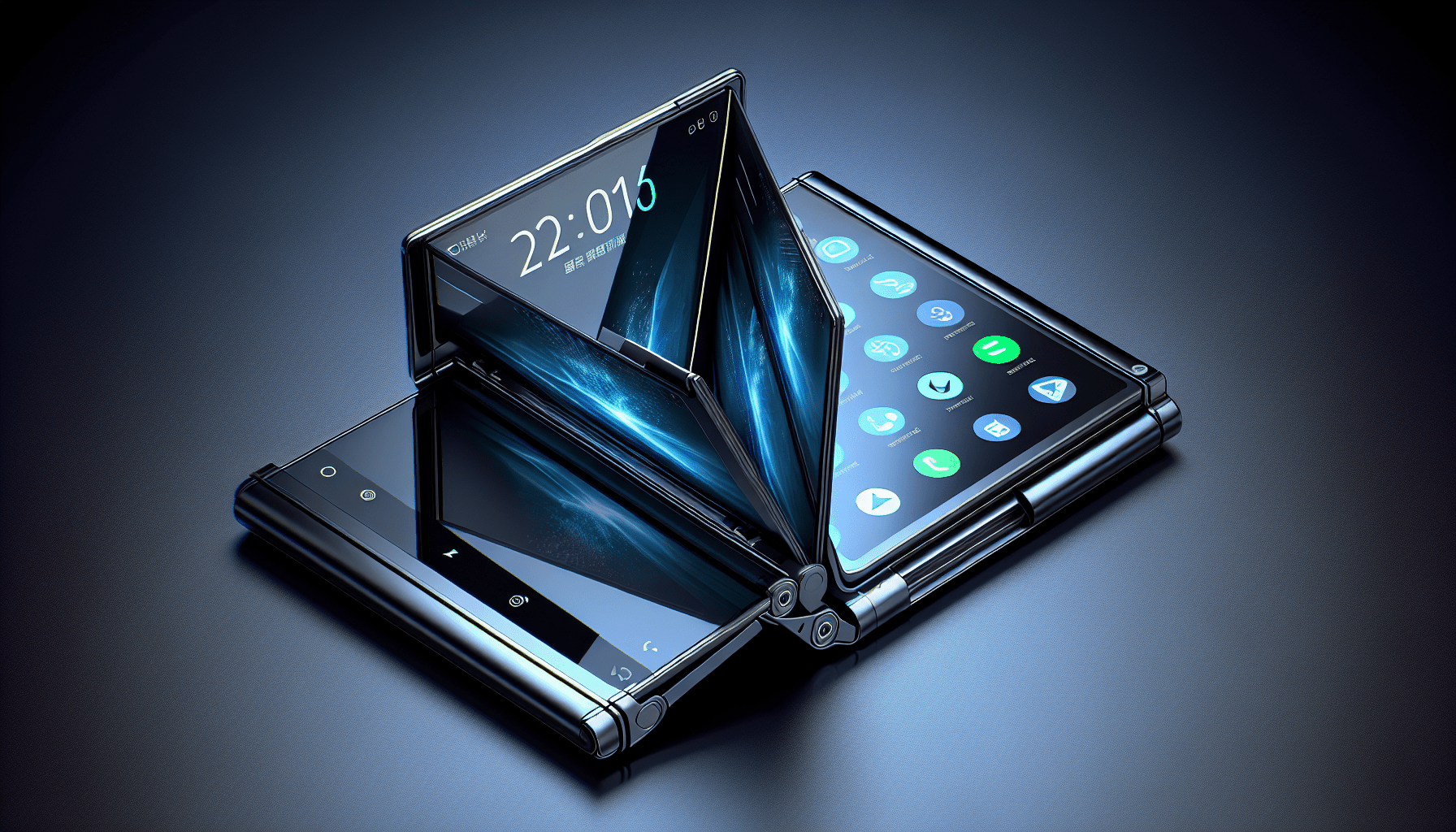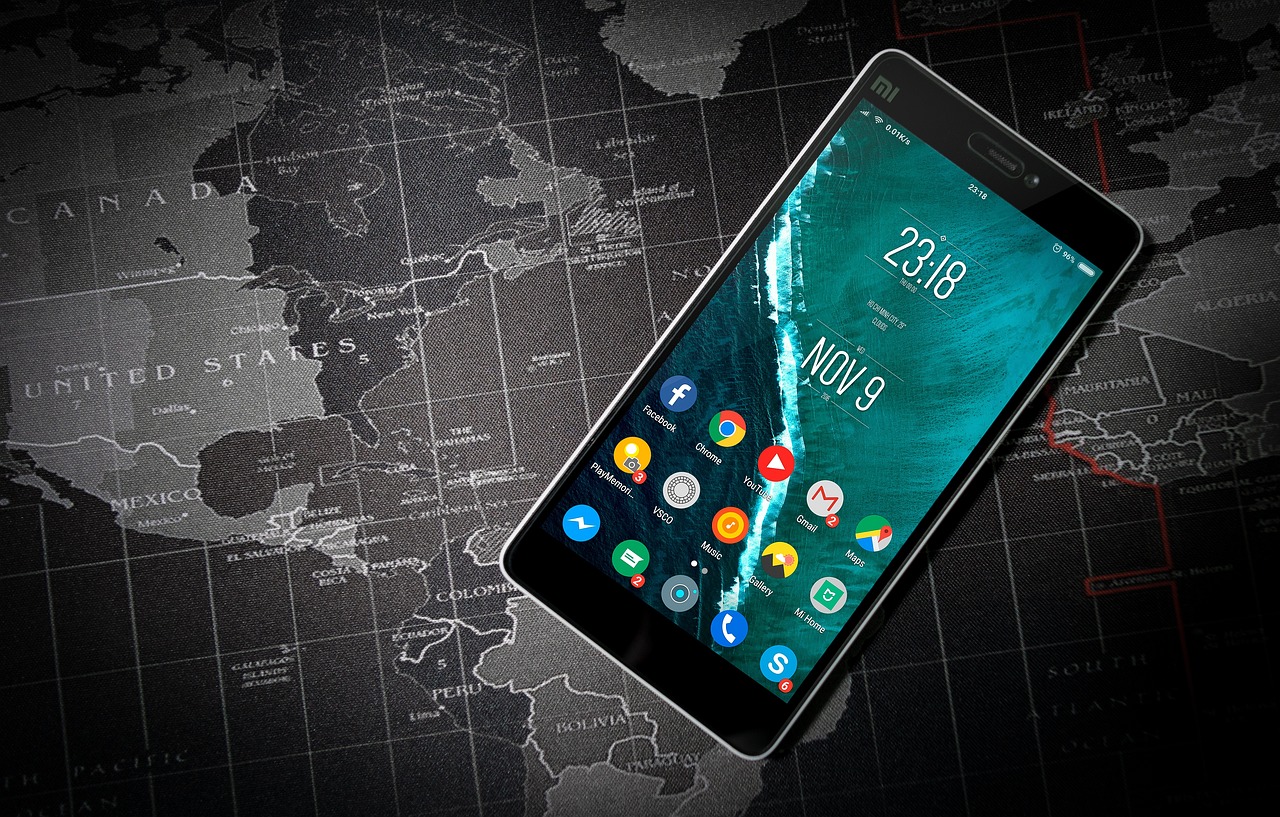Are you someone who likes to stay up-to-date with the latest technological advancements? If so, you might have noticed the recent surge in popularity of foldable phones. These innovative devices have captured the attention of tech enthusiasts around the world, promising a unique blend of style and functionality. In this article, we will take a closer look at the rise of foldable phones and why they are quickly becoming the hottest trend in the smartphone industry. Get ready to be amazed by the possibilities that unfold!

The History of Foldable Phones
Early Concepts and Prototypes
The concept of foldable phones has been around for quite some time, with early concepts and prototypes dating back to the early 2000s. However, it wasn’t until recent years that this technology began to gain significant attention and traction in the market. Companies like Samsung, Huawei, and Motorola have been at the forefront of developing and refining the technology behind foldable phones, pushing the boundaries of what was previously thought possible.
First Generation Foldable Phones
The first generation of foldable phones hit the market in the late 2010s, marking a significant milestone in the evolution of smartphone design. Samsung’s Galaxy Fold and Huawei’s Mate X were amongst the first commercially available foldable phones, showcasing the potential of this innovative form factor. These devices featured large, flexible displays that could be folded in half, offering users a unique and immersive experience.
Advancements in Foldable Technology
Since the introduction of the first generation of foldable phones, there have been significant advancements in the technology. Manufacturers have focused on improving the durability of foldable screens, addressing concerns about potential damage and creasing. Additionally, software advancements have been made to optimize the user experience on foldable devices, allowing for seamless multitasking and enhanced performance. These advancements have paved the way for the next generation of foldable phones, offering even more exciting features and capabilities.
Benefits and Drawbacks of Foldable Phones
Increased Screen Real Estate
One of the key benefits of foldable phones is the increased screen real estate they offer. With a larger folded-out display, users can enjoy a more immersive viewing experience for multimedia content, such as videos and games. The expanded screen size also allows for more efficient multitasking, as users can view multiple apps or windows side by side.
Improved Portability
Foldable phones also offer improved portability compared to traditional smartphones. When folded, these devices are compact and can easily fit into pockets or small bags, making them more convenient to carry around. The ability to have a larger screen that can be folded away when not in use provides the best of both worlds in terms of screen size and portability.
Multitasking Capabilities
Foldable phones have the potential to revolutionize multitasking on smartphones. With their larger displays, users can effortlessly multitask by having multiple apps open simultaneously. For example, you can browse the web while watching a video, or take notes while attending a virtual meeting. The ability to seamlessly switch between apps and utilize the expanded screen space enhances productivity and efficiency.
Durability Concerns
One drawback of foldable phones is the concern over their durability. The folding mechanism and flexible display introduce potential points of weakness that could result in damage or screen failure over time. Manufacturers have made significant strides in improving the durability of foldable phones, but it remains an ongoing challenge to strike the right balance between flexibility and durability.
Higher Cost
Another drawback of foldable phones is their higher cost compared to traditional smartphones. The advanced technology and materials used in the design and production of foldable phones contribute to their elevated price tags. As the technology matures and becomes more commonplace, it is expected that the cost will decrease, making foldable phones more accessible to a wider range of consumers.

Major Players in the Foldable Phone Market
Samsung
Samsung has been a major player in the foldable phone market since the introduction of the Galaxy Fold. The company has continued to innovate and improve its foldable devices, offering consumers a range of options to choose from. Samsung’s foldable phones feature high-quality displays, powerful processors, and an array of unique software features tailored to enhance the foldable experience.
Huawei
Huawei has also made significant strides in the foldable phone market, with its Mate X series. Known for its cutting-edge technology and design, Huawei has successfully combined premium materials with exceptional performance. The Mate X series boasts impressive camera capabilities, seamless multitasking, and a sleek design that showcases the company’s commitment to innovation.
Motorola
Motorola, a company with a rich history in mobile phone technology, made a comeback in the foldable phone market with the revival of the iconic Razr. The Motorola Razr features a nostalgic flip phone design with a foldable display, catering to those who appreciate a blend of modern technology and classic aesthetics. The Razr offers a compact form factor when folded and an extended display when unfolded, making it an attractive option for those seeking a unique foldable experience.
Xiaomi
Xiaomi has also joined the foldable phone market with its Mi Mix Fold. The Mi Mix Fold showcases Xiaomi’s dedication to pushing boundaries and offering innovative features to its consumers. With a large foldable display, powerful hardware, and an impressive camera system, Xiaomi has positioned itself as a strong competitor in the foldable phone market.
Microsoft
Microsoft, known for its software prowess, entered the foldable phone market with the Surface Duo. The Surface Duo offers a dual-screen experience, enabling users to multitask efficiently. With Microsoft’s expertise in productivity tools and software integration, the Surface Duo aims to cater to professionals and creative individuals who require a seamless transition between work and play.
Current Foldable Phone Models
Samsung Galaxy Fold
The Samsung Galaxy Fold is one of the most well-known and widely recognized foldable phones in the market. It features a 7.3-inch Infinity Flex Display that folds inward, offering users a tablet-like experience when unfolded and a compact smartphone-like experience when folded. The Galaxy Fold also boasts powerful hardware, a versatile camera system, and a host of software features optimized for the foldable form factor.
Huawei Mate Xs
The Huawei Mate Xs is Huawei’s flagship foldable phone, featuring an 8-inch flexible OLED display that folds outward. This design allows for a seamless transition between the folded and unfolded states, offering users a large canvas for productivity and multimedia consumption. The Mate Xs also incorporates Huawei’s powerful Kirin processors, exceptional camera capabilities, and a durable hinge mechanism.
Motorola Razr
The Motorola Razr brings a nostalgic flip phone design to the foldable phone market. With a unique clamshell design, the Razr offers a compact form factor that easily fits into pockets or small bags. When unfolded, the Razr reveals a 6.2-inch Flex View display, providing users with a spacious screen for their everyday mobile needs. Motorola has also focused on incorporating smart features, such as a Quick View external display for enhanced productivity and convenience.
Xiaomi Mi Mix Fold
Xiaomi’s entry into the foldable phone market, the Mi Mix Fold, features an 8.01-inch Quad HD+ flexible Samsung AMOLED display. This foldable device offers a large screen for immersive viewing and multitasking capabilities. The Mi Mix Fold also boasts a powerful Qualcomm Snapdragon processor, a versatile camera setup co-developed with Xiaomi’s camera division, and a robust cooling system to ensure optimal performance.
Microsoft Surface Duo
The Microsoft Surface Duo takes a unique approach to foldable phones by offering a dual-screen experience. When unfolded, users are greeted with two 5.6-inch PixelSense Fusion displays connected by a 360-degree hinge. This design allows for seamless multitasking, with each screen capable of running different apps or functioning as a single large canvas. The Surface Duo showcases Microsoft’s commitment to productivity and integration with its suite of productivity tools.

Evolving Design and Features of Foldable Phones
Inward vs. Outward Folding
One aspect of foldable phone design that has evolved over time is the direction in which the device folds. The early generations of foldable phones predominantly featured inward folding, where the screen folds inward like a book. However, recent models, such as the Huawei Mate Xs, have adopted outward folding, where the screen folds outward, resembling a tablet when unfolded. This evolution in design offers different user experiences and preferences.
Reduced Crease and Improved Flexibility
Reducing the crease that forms in the middle of the display when a foldable phone is folded has been a major focus for manufacturers. Through advancements in display technology and material science, companies have been able to minimize the visible crease, resulting in a more seamless user experience. Additionally, improvements in the flexibility of the display allow for smoother folding and unfolding, enhancing the overall usability of foldable phones.
Enhanced User Interface
Foldable phones require a user interface that can adapt to different display configurations and orientations. Manufacturers have worked on optimizing the user interface to make the most of the expanded screen real estate when unfolded and ensure a smooth transition between folded and unfolded states. This includes features like app continuity, which allows apps to seamlessly transition from the cover display to the main display when the device is unfolded.
Integration of Stylus Pens
Some foldable phones, such as the Samsung Galaxy Fold and Microsoft Surface Duo, have incorporated support for stylus pens. This integration allows users to take advantage of precise input for note-taking, drawing, and other creative tasks. The use of a stylus pen on a larger foldable display offers a more natural and immersive writing experience.
Advanced Camera Systems
Foldable phones have not compromised on camera capabilities. Manufacturers have managed to incorporate advanced camera systems into their devices, offering users high-quality photography and video recording experiences. Some foldable phones feature multiple camera sensors, including wide-angle, ultra-wide-angle, and telephoto lenses, providing versatile shooting options. These advanced camera systems ensure that users can capture cherished moments with clarity and detail.
Challenges and Limitations in Foldable Phone Technology
Fragility of Foldable Screens
One of the main challenges in developing foldable phones is the fragility of the foldable screens. The flexible display technology used in these devices is still relatively new, and ensuring its durability has been a major focus for manufacturers. Despite significant advancements, foldable screens remain more susceptible to damage from impacts and pressure compared to traditional smartphone displays. It is crucial for manufacturers to continue refining the technology to improve the durability of foldable screens.
Battery Life and Performance
Foldable phones require robust hardware to power their larger displays and advanced features. This can result in increased power consumption, which poses a challenge in terms of battery life. Manufacturers have been working on optimizing power management and efficiency to ensure that foldable phones offer a satisfactory battery life. Balancing performance, power consumption, and battery life remains an ongoing challenge in the development of foldable phone technology.
App Compatibility
The unique form factor of foldable phones requires applications to be optimized for the folded and unfolded states. While many popular apps have been updated to support foldable displays, there are still some limitations in terms of app compatibility. Developers have to consider different screen resolutions, aspect ratios, and multitasking capabilities when designing and adapting their apps for foldable phones. Ensuring a seamless and consistent user experience across a wide range of applications is crucial for the success of foldable phones.
Pricing Barrier
Foldable phones are currently positioned as premium devices in the market, with higher price points compared to traditional smartphones. The advanced technology and materials used in their production contribute to their elevated cost. This pricing barrier limits the accessibility of foldable phones to a wider consumer base. As the technology matures and manufacturing costs decrease, it is expected that the prices will become more competitive, making foldable phones more affordable and appealing to a broader audience.
Potential Future Developments and Innovations
Thinner and Lighter Form Factors
As the technology behind foldable phones continues to evolve, manufacturers are likely to focus on creating thinner and lighter devices. This involves advancements in materials, such as thinner glass or flexible plastics, to reduce the overall thickness and weight of foldable phones. A thinner and lighter form factor would enhance the portability and user experience of foldable phones.
Advanced Hinge Mechanisms
The hinge mechanism is a critical component of foldable phones, allowing for smooth folding and unfolding. Manufacturers are expected to continue refining and innovating hinge designs to improve durability, flexibility, and smoothness of operation. Advanced hinge mechanisms could enable foldable phones to withstand constant folding and unfolding without compromising on performance or reliability.
Flexible Batteries
The integration of flexible batteries is another area of potential innovation in foldable phones. Flexible batteries would allow for more efficient use of space within the device, enabling slimmer designs and increased battery capacity. This would address the challenge of balancing power consumption and battery life, providing users with longer usage times without sacrificing portability.
Integration of 5G Technology
Foldable phones are well-positioned to take advantage of the next-generation 5G network. As 5G technology continues to roll out globally, manufacturers are likely to incorporate 5G connectivity in their future foldable phone models. This integration would provide users with faster download and upload speeds, low latency, and enhanced connectivity for a seamless and immersive smartphone experience.
Augmented Reality Applications
Foldable phones offer an ideal platform for augmented reality (AR) applications. The large foldable displays can provide users with immersive AR experiences, whether it’s gaming, education, or entertainment. Manufacturers may explore partnerships and collaborations with AR developers to create innovative and captivating AR experiences specifically designed for foldable phones.
Consumer Reception and Market Growth
Early Adoption and Enthusiasm
Despite being a relatively new technology, foldable phones have garnered significant attention and enthusiasm from early adopters and tech enthusiasts. The unique form factor and advanced features have piqued curiosity and generated excitement around foldable phones. As more manufacturers enter the foldable phone market and release new models, consumer interest is expected to grow, driving further adoption and market growth.
Competitive Pricing and Availability
As the market for foldable phones becomes more competitive, manufacturers are likely to focus on pricing and availability to attract a wider consumer base. By offering more affordable options and expanding distribution channels, manufacturers can make foldable phones more accessible to the general public. Competitive pricing and availability will be key factors in driving the adoption of foldable phones and increasing market penetration.
Projected Market Expansion
Industry experts predict significant market expansion for foldable phones in the coming years. With continuous advancements in technology, refinement of designs, and increasing consumer demand, the market for foldable phones is expected to grow exponentially. As the benefits and capabilities of foldable phones become more widely recognized and appreciated, they are likely to become a mainstream choice for smartphone users.
Implications for the Smartphone Industry
Influencing Design Trends
The introduction of foldable phones has already started to influence design trends in the smartphone industry. Manufacturers are exploring new form factors, materials, and features to differentiate their offerings and cater to consumers’ evolving preferences. The emphasis on larger displays, multitasking capabilities, and unique folding mechanisms showcases the impact of foldable phones on shaping the future of smartphone design.
Shifting Market Dynamics
Foldable phones have the potential to disrupt the traditional smartphone market. As more manufacturers enter the foldable phone market and offer compelling options, consumer preferences and purchasing patterns are likely to shift. Traditional smartphones may face challenges in retaining market share as consumers gravitate towards the unique and immersive experiences offered by foldable phones. This shift in market dynamics could lead to a redefinition of the smartphone industry and the way we interact with our devices.
Disruption of Traditional Form Factors
Foldable phones challenge the conventional concept of a smartphone through their folding displays and adaptable form factors. This disruption may pave the way for new categories of devices that blur the lines between smartphones, tablets, and even laptops. The versatility and flexibility of foldable phones have the potential to reshape the way we use and perceive our mobile devices, opening up new possibilities for innovation and user experiences.
Conclusion
The rise of foldable phones has brought about a new era of smartphone design and functionality. From early concepts and prototypes to the current generation of foldable phone models, manufacturers have made significant advancements in foldable technology. While there are benefits and drawbacks to consider, such as increased screen real estate and durability concerns, the market for foldable phones continues to grow rapidly.
Major players like Samsung, Huawei, Motorola, Xiaomi, and Microsoft have introduced innovative foldable phones, each with their unique features and design philosophies. As the technology behind foldable phones evolves, we can expect thinner and lighter form factors, improved hinge mechanisms, flexible batteries, integration of 5G technology, and augmented reality applications in the future.
Consumer reception and market growth for foldable phones have been positive, with early adopters and tech enthusiasts expressing enthusiasm for this innovative form factor. Competitive pricing and availability will be crucial in driving further adoption and market expansion. The impact of foldable phones extends beyond their own market, influencing design trends and shifting dynamics in the overall smartphone industry.
In conclusion, foldable phones represent a significant leap forward in smartphone technology, offering users a unique and immersive experience. As the technology matures and becomes more accessible, foldable phones are poised to become mainstream options, shaping the future of mobile devices.



